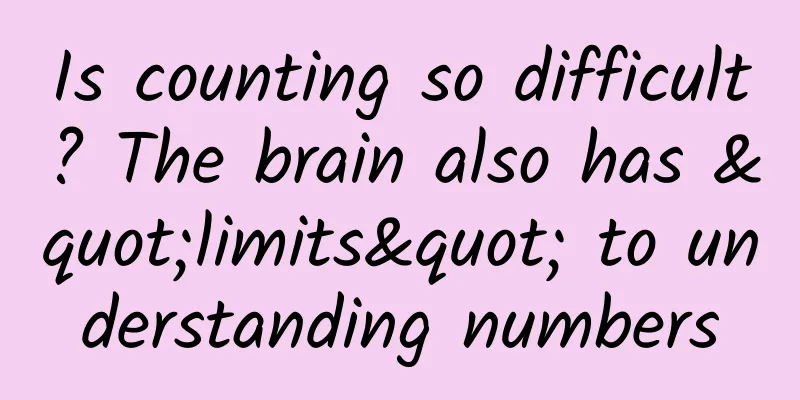Is counting so difficult? The brain also has "limits" to understanding numbers

|
For numbers greater than 4, the activation of digital nerves becomes blurred and the error rate increases. However, for numbers 4 and less than 4, almost only the nerves corresponding to the numbers are activated, and the probability of incorrect activation is very low, indicating that the brain will first roughly estimate how many objects it sees, and then accurately estimate the specific number, indicating that the brain may have an additional error correction mechanism for the recognition of small numbers. How humans understand numbers is a century-old puzzle. Recently, there has been a breakthrough in this puzzle. German scientist Esther Coote and other researchers published a paper titled "Different neuronal representations of small and large numbers in the human medial temporal lobe" in the latest issue of the internationally renowned journal Nature Human Behavior, which confirmed for the first time in history that human neurons encode a "boundary" around the number 4. Do humans have an innate ability to understand numbers? This question has been controversial. Some people believe that children are born with the ability to understand numbers, while others believe that this ability needs to be learned. The understanding of numbers should include two meanings: one is to distinguish the number and size of objects, and the other is to count and perform accurate calculations. Babies seem to have an innate ability to distinguish numbers. If two piles of toys or food with different numbers are placed in front of babies, they will tend to crawl to the pile with more objects. However, counting and calculating correctly requires long-term and continuous teaching by parents and teachers. Many animals also demonstrate the ability to understand numbers. Monkeys will quickly assess the number of fruits on two trees and the number of their competitors to decide which tree to go to forage, and solitary male lions will also assess the number of rival lions to choose to fight or flee. Both humans and animals have the ability to understand numbers, but humans are clearly superior, which has aroused people's curiosity about how the brain learns to count and calculate. We can play an interesting game. Take out a handful of beans and randomly select a few beans for children who have learned to count. The rules of the game are that they can only take a look and then tell how many beans there are based on their feelings. In most cases, when the number of beans is 4 or less, the children's accuracy is the highest; when the number of beans is more than 4, especially more than 10, many people can hardly tell how many beans there are based on a momentary impression. In 1871, this experiment was first proposed by British scientist Stanley Jevon and published in the journal Nature under the title "The Ability to Distinguish Numbers". The results of this experiment show that it is easy for humans to distinguish and master small numbers, but it is more difficult for large numbers. In 2002, American scientist Andreas Nied and others discovered in their study of monkey behavior that there are some nerves in the monkey's brain that are sensitive to numbers. When seeing a specific number, these nerves are activated and continuously send out electrical signals. Moreover, these nerves will also send out electrical signals when adjacent numbers appear, but not as frequently. Later, German scientist Helen Dietz and others also found similar digital nerves in the brains of crows. So, does the human brain also use the same digital nerves to understand numbers? In October 2023, researchers such as Esther Coote completed related experiments with the help of epilepsy patients in neurosurgery. The reason why epilepsy patients were chosen as subjects is that electrodes have been implanted in their temporal lobes to help these patients fight epileptic seizures, and these electrodes can also be used to record the electrical signals of single nerves when the human brain recognizes numbers or counts. The experimental results show that the human brain uses two completely different mechanisms to process numbers: for numbers greater than 4, the activation of digital nerves becomes blurred and the error rate increases, while for numbers 4 and less than 4, almost only the corresponding digital nerves are activated, and the probability of incorrect activation is very low. This shows that the brain will first roughly estimate how many objects are seen, and then accurately calculate the number, but this accuracy is only effective for small numbers, indicating that the brain may have an additional error correction mechanism for the recognition of small numbers. The different processing mechanisms of the temporal lobe for small and large numbers reveal the existence of a clear numerical boundary in the temporal lobe. Because the temporal lobe of the brain is related to human memory and perception, human memory and attention may also have different mechanisms for small and large things, and affect people's performance in learning and work. Researchers have found that the temporal lobe of the brain is significantly activated when children learn to count or multiplication formulas, which can explain why children find it easy to learn small numbers but find it difficult to master large numbers. In the future, as we conduct more in-depth research on how other brain areas understand numbers, perhaps we can better design educational methods to teach children to master counting and calculation in an easier way. At the same time, understanding how the brain understands numbers can also help us better understand how humans master mathematics, and then possibly design machines that are smarter than the human brain. (Wang Linlin is a member of Jilin Province Science Popularization Creation Association and an assistant researcher at Jilin Province Science and Technology Workers Service Center; Liu Chuanbo is a member of Jilin Province Science Popularization Creation Association and a doctor at Changchun Institute of Applied Chemistry, Chinese Academy of Sciences) |
Recommend
Analysis of JD Finance’s private domain operations!
Regarding the financial industry's approach t...
Tesla's Q2 revenue was $2.8 billion, with a net loss of $300 million and its automotive revenue doubled year-on-year
On August 3, Tesla announced its second quarter f...
Will drinking ice water often hurt your stomach? Will drinking hot water be fine?
Reviewer of this article: Chen Haixu, Deputy Dire...
Case: Analyzing effective promotion strategies in the early stages of a product!
"The successful execution of a plan that mak...
How much does it cost to be an agent for a mobile app in Nagqu?
How much does it cost to be a mobile app agent in...
Apple iOS 16 hidden system exposed: detect user country/region more accurately and restrict specific functions
On April 26, according to foreign media 9to5Mac, ...
Why is jealousy “eating jealousy” instead of “eating salt” or “eating oyster sauce”?
References [1] Talks of Sui and Tang Dynasties [T...
Will artificial intelligence be the terminator of the fierce competition in cloud computing?
Recently, the well-known market research organiza...
How much does it cost to join the Wuhai food delivery app? What is the price for joining the Wuhai food delivery app?
Is it easy to join the Wuhai food delivery mini p...
Incredible! In just 25 steps, a chip can turn skin into blood vessels and nerve cells
Using a chip to instantly turn your skin tissue i...
Tesla's old Model 3 price cut by RMB 10,000 to clear inventory, netizens: Don't be fooled
Tesla, which adopts the direct sales model, has a...
[Case] 17 pictures to understand the functional development and analysis of Meituan.com’s campus channel structure!
17 pictures to understand the development and ana...
Trivia! You can make your girlfriend unable to stand up with just one finger
[Director explains] Now, let me explain to you wh...
The red and black of pre-installed software: from cancer to ecology, from addition to subtraction
[[149497]] On September 16, Apple CEO Tim Cook sa...
"Laso" first obtains cosmic rays in the W51 region, key evidence of the acceleration limit|Bolan Daily
" Laso " receives cosmic rays from W51 ...









